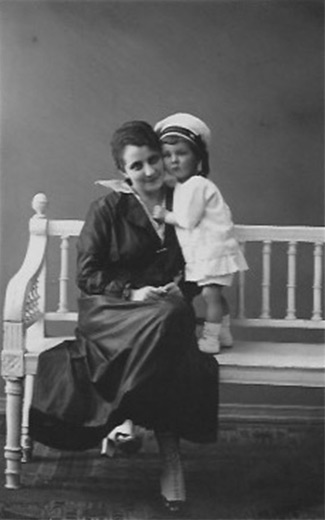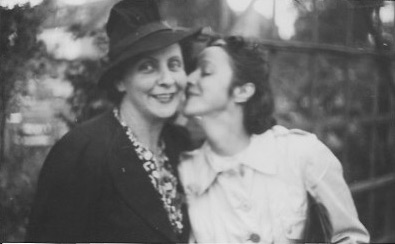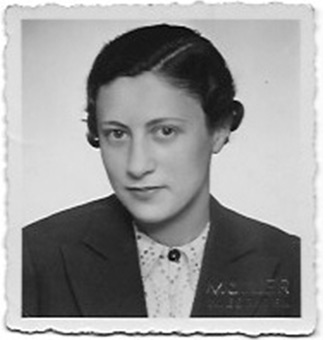Berlin Stories The sisters Lily and Elsa Katz
Nikolsburger Platz 4, 10717 Berlin und Wielandstraße 30, 10629 Berlin

“I was born in 1944 to refugee parents – my father Lothar was from Hanover and my mother Mimi from Vienna.”
We lived in a suburban London house in Wembley – beyond the door was austerity Britain, rationing, smog, the celebration of Empire Day at my school. But once through the front door you were in Middle Europe. The furniture my sophisticated grandmother Lily had brought from Berlin graced every room, on Saturday afternoons my mother baked Viennese pastries and cakes, Linzertorte, Apfelstrudel, Spitzbuben, Sachertorte with schlag. Every Sunday morning my father played chess and in the afternoon their friends came for tea- all continental – from Germany, Austria, Hungary and Czechoslovakia. I learned German by osmosis.
I remember too being frightened by a huge black Japanese cabinet, which stood ceiling high in our lounge. I imagined as a child that the menacing eagles, dragons and apes carved all over it were monsters who would come for me in my dreams. Inside the cabinet were other precious mysteries, Bohemian glass, Dresden china, monogrammed pink damask tablecloths, and the solid, warm curves of a sumptuous silver coffee set. The cabinet and its treasures, the Persian carpets, porcelain Meissen figurines, the paintings had all been the property of my grandmother Lily. My father was her only child from her first marriage to Leopold Sauer.

Lily was born in Hanover but lived in Berlin. She divorced her first husband and then married Franz Knips who was not Jewish. He died in 1935. At that time Lily lived in Berlin-Schöneberg in Freiherr-vom-Stein Strasse 8 but moved eventually to Wielandstrasse 30 in Berlin-Charlottenburg.

Lily and Leopold had prescience and sent their son in 1933 to London to study at the London School of Economics. He subsequently met and married my mother and they made their life there.
As the Nazi’s took a grip on Germany and Europe Lily was in fear of her life. My father managed to get her out of Berlin in 1939 and she came to London.
In Berlin she had led a cultured and affluent life – now she was a refugee in a grey war–riven Britain, dislocated, living in a cold rented flat with lodgers, trying to come to terms with a totally new culture as did many others.
Llly suffered from depression. This was further exacerbated by an unhappy love affair. Whilst trying to escape from Berlin she had met a man, a non-Jew, Josef Jakobs who had a business providing passports to ‘help’ Jews get out of Germany. In the course of their dealings they had a love affair. He was eventually arrested by the Gestapo for creating these passports and pocketing the proceeds. Jakobs was sent to Sachsenhausen Concentration Camp. The only way he could get out was by agreeing to work for the Abwehr as a spy. He would be sent to England having been trained to send weather reports back from Britain to the Luftwaffe for their bombing raids. He was parachuted in January 1941 but he was immediately captured by the Home Guard as he broke his ankle on his descent. Lily’s name and address was on a piece of paper in his pocket. Did he intend to be a spy – did he intend to find Lily and implicate her in his espionage or simply get her to hide him? Imprisoned, interrogated, court-martialled, as he had been a former soldier, Jakobs was finally shot at the Tower of London. His fame rests on the fact he was last man ever to be executed there.
His death and her refugee life apparently proved too much for Lily and she became a casualty of the war by committing suicide by gas in 1943. She was 52 years old, an event from which my brilliant, troubled father never recovered.

Lily had a sister, Elsa born in 1890. She married and divorced Alfons Majewski. She was a medical nurse but could not work as such being Jewish. She lived in Nikolsburger Platz 4 in Berlin-Wilmersdorf until 1940 in a building where 10 other Jewish people lived. She then was forced to move to a ‘Judenwohnung’ in Holsteinische Strasse 9 in Berlin-Schöneberg. Elsa was then deported on 13th June 1942 from Gleis 17 to Sobibor where she was murdered.

The Nikolsburger Platz building was bombed and the site became the playground of the nearby Cecilien Schule. They have commemorated what happened to the Jewish occupants of the bombed building by laying 11 stolpersteine that encapsulate their fate. The school lays roses on the stolpersteine every year and lights candles.
After Elsa died her landlord sold two sofas and two cushions for 10m, all that was left of her worldly goods but it was noted in 1943 in the Brandenburg state archives that ‘the emigrated Jew Majewski still had a property tax debt amounting to 90m.
My childhood home had beautiful objets d’art and fine furniture, and laughter was present when there were visitors but at other lonelier times it reflected the darkness, guilt and absences of the past. We were all haunted by the tragic family history of Lily and Elsa and also what happened to my mother’s parents in Vienna. There was no remedy. No exorcism could prevail.
Sylvia Paskin, London, 2018




